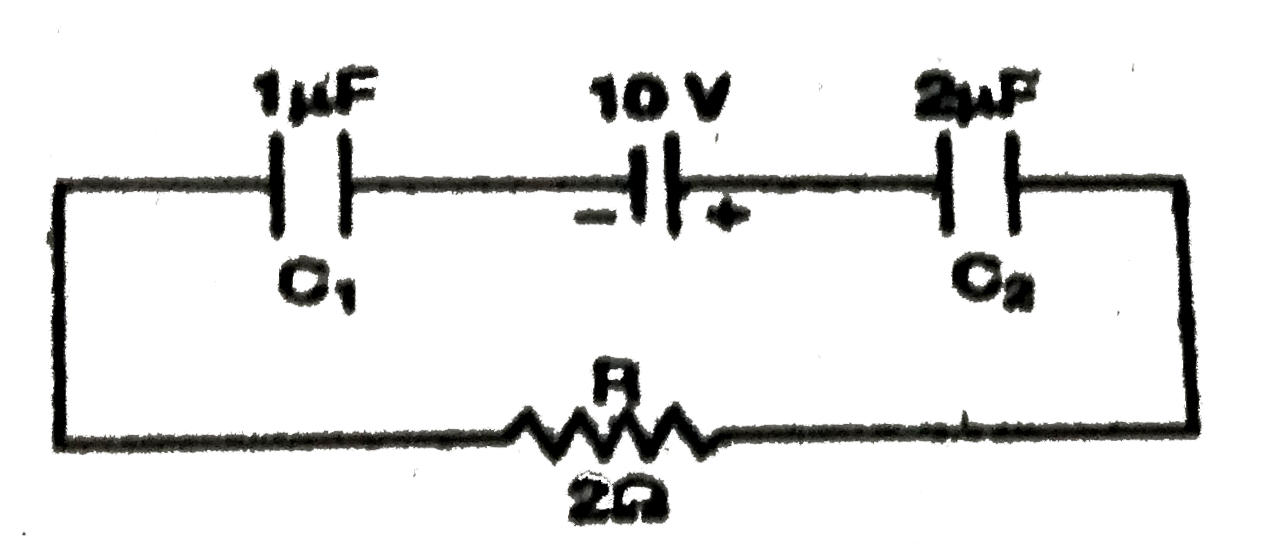The given graph [Figure] shows variation of charge 'q' versus potential difference V for two capacitors C1andC2. Both the capacitors have same plate separation but plate area of C2 is greater then that of C1. Which line (A or B) corresponds to C1 and why ?
![The given graph [Figure] shows variation of charge 'q' versus potential difference V for two capacitors C1 and C2. Both the capacitors have same plate separation but plate area of C2 is greater then that of C1. Which line (A or B) corresponds to C1 and why ?](https://d10lpgp6xz60nq.cloudfront.net/physics_images/U_LIK_SP_PHY_XII_C02_E08_038_Q01.png)
As plate area of C2 is greater than that of C1, hence C2>C1. As C=qV and from given graphs we conclude that CA>CB. Thus, line A represents C2 and line B represents C1.
Topper's Solved these Questions
- ELECTROSTATIC POTENTIAL AND CAPACITANCE BOOK - U-LIKE SERIESCHAPTER - ELECTROSTATIC POTENTIAL AND CAPACITANCE EXERCISE - SHORT ANSWER QUESTIONS
48 Videos
- ELECTROSTATIC POTENTIAL AND CAPACITANCE BOOK - U-LIKE SERIESCHAPTER - ELECTROSTATIC POTENTIAL AND CAPACITANCE EXERCISE - LONG ANSWER QUESTIONS-I
64 Videos
- ELECTROSTATIC POTENTIAL AND CAPACITANCE BOOK - U-LIKE SERIESCHAPTER - ELECTROSTATIC POTENTIAL AND CAPACITANCE EXERCISE - ASSERTION-REASON TYPE QUESTIONS
5 Videos
- ELECTROMAGNETICE INDUCTIONBOOK - U-LIKE SERIESCHAPTER - ELECTROMAGNETICE INDUCTIONEXERCISE - Self Assessment Test Section -D
1 Videos
- EXAMINATION PAPER 2020 (SOLVED)BOOK - U-LIKE SERIESCHAPTER - EXAMINATION PAPER 2020 (SOLVED)EXERCISE - SECTION D
6 Videos
Similar Questions
The given graph shows variation of charge .q. versus potential difference .V. for two capacitors

C1andC2. Both the capacitors have same plate separation but plate area of C2 is greater than that of C1. Which line (A or B) corresponds to C1 and why?
View SolutionThe given graph in Fig. shows the variation of charge q versus potential difference for two capacitors C1andC2. The two capacitors have same plate sepration, but the plate area of C2 is double that of C1.

Which of the lines in the graph correspond to C1andC2 and why ?
View Solution
Knowledge Check
A capacitor C is charged to a potential difference V and battery is disconnected. Now if the capacitor plates are brough close slowely by some distance:
Asome +ve work is done by external agentBenegry of capacitor will decreaseCenegry of capacitor will increaseDnone of the aboveA 10V battery is connected to two capacitors C1 and C2 and a resistor R. When the capacitors are fully charged, then the potential difference across the resistor will be
 A10 VB5VC3.33 VDzero
A10 VB5VC3.33 VDzeroTwo capacitors C1 and C2 are charged to same potential V, but with opposite polarity as shown in the figure. The switches S1 and S2 are then closed
 APotential difference across two capacitors are same and is given by (C1−C2)VC1+C2BPotential difference across two capacitors are same and is given by (C1+C2C1−C2)VCRatio of final energy to initial energy of the system is given by (C1−C2)2(C1+C2)2DRatio of final energy to initial energy of the system is given by (C1)2(C1+C2)2
APotential difference across two capacitors are same and is given by (C1−C2)VC1+C2BPotential difference across two capacitors are same and is given by (C1+C2C1−C2)VCRatio of final energy to initial energy of the system is given by (C1−C2)2(C1+C2)2DRatio of final energy to initial energy of the system is given by (C1)2(C1+C2)2
Shows these variation of charge q for two capacitors C1 and C2 The two capacitors have the same plate separation. But the plate area of C2 is double than that of C1. Which of the lines in the figure corresponds to C1 and C2 and why?
 .
.
View SolutionShows these variation of charge q for two capacitors C1 and C2 The two capacitors have the same plate separation. But the plate area of C2 is double than that of C1. Which of the lines in the figure corresponds to C1 and C2 and why?
 .
.
View SolutionTwo capacitors C1andC2 have the same separation between the plates but the plate area of C2 is twice that of C1. The given graph shows the variation of q with V. Which of the two lines in the graph represents C1 and why?

View SolutionIn the figure shown below, find out the current as function of time and charge on capacitor C1and also plot the graph of charge on plate A and B of capacitor C2 as a function of time.

View SolutionA 10V battery is connected to two capacitors C1 and C2 and a resistor R. When the capacitors are fully charged, then the potential difference across the resistor will be

View Solution
